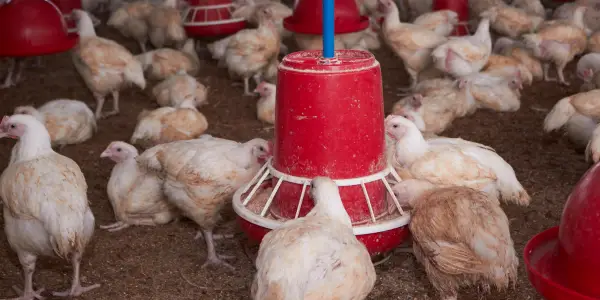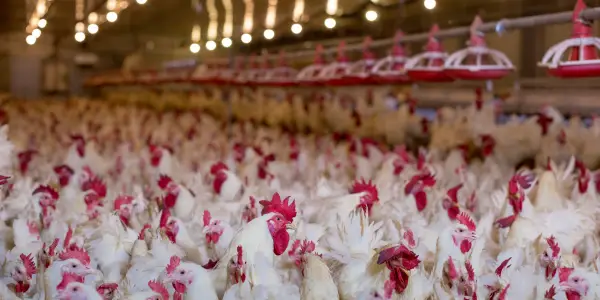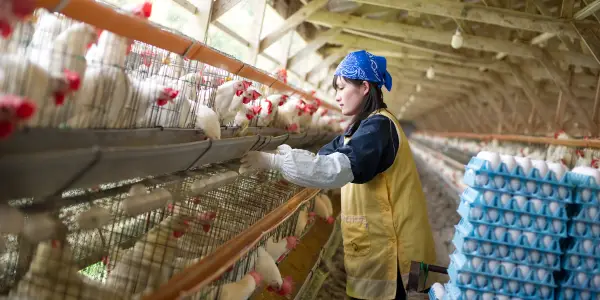Table of Contents
ToggleIn this article, we will explore the key components of a comprehensive poultry farm business plan in India. We will discuss the importance of conducting a market analysis, developing a sound business model, creating a financial plan, and implementing an effective marketing strategy.

After reading the article you can download the Poultry Business Plan PDF as wel as Power Point Presentation for Investor or Bankers. You can also read the poultry farm business plan in hindi, please use the google translator buttom floating at the right hand side of your screen.
Additionally, in this Poultry Farm Business Plan article we will analyze potential risks and challenges associated with poultry farming in India and provide practical risk management strategies. Whether you are a first-time entrepreneur or an experienced business owner, this Poultry Farming Business Plan article will provide you with valuable insights and practical tips for launching and running a successful poultry farm in India.
Why making a Poultry farm business plan is Important before you start?

Having a well-designed poultry farm business plan is crucial for any aspiring poultry farming entrepreneur in India. The following are some of the reasons why having a business plan is essential,
Provides direction and clarity: A business plan helps entrepreneurs to define their goals, objectives, and strategies for achieving them. Similarly, you must include all these aspects in the Poultry farm business plan befor you begin. It will help providing a clear roadmap for the business, outlining the steps required to launch and run a successful poultry farming.
Helps secure financing: A comprehensive business plan is often required by banks and investors to evaluate the viability and potential of a business. A well-designed poultry farm business plan can help entrepreneurs to secure financing, by demonstrating the potential return on investment and the risks involved.
Facilitates decision-making: A business plan helps entrepreneurs to make informed decisions about critical aspects of their business, such as pricing, marketing, and supply chain management. So, if a poultry farm business plan holds all such different scenarios and options, entrepreneurs can make well-informed decisions that maximize their chances of success.
Provides a framework for monitoring and evaluation: A business plan serves as a framework for monitoring and evaluating the performance of the business. Entrepreneurs must include in the poultry farm business plan to track their progress, identify areas that need improvement, and make necessary adjustments.
How big is poultry business in India?

The Indian poultry industry is a rapidly growing sector that has experienced significant expansion over the past few decades. It is one of the largest producers of eggs and broilers (chickens raised for meat) in the world, with a domestic market estimated to be worth over USD 17 billion. The industry is diverse and consists of various types of farms, ranging from small backyard production to large commercial operations.
The major types of poultry farming in India are broiler and layer farming. Broiler farming involves raising chickens for meat production, while layer farming involves raising hens for egg production. Both types of farming require specific infrastructure, equipment, and management practices.
In recent years, the Indian government has been promoting the poultry industry through various schemes and initiatives, such as the National Livestock Mission, the National Programme for Bovine Breeding and Dairy Development, and the Rashtriya Krishi Vikas Yojana. Additionally, the industry has been adopting various technological advancements, such as automation, biotechnology, and genetic selection, to improve productivity, efficiency, and quality.
According to a report by Research and Markets, the Indian poultry market is expected to grow at a CAGR of around 8% during the forecast period of 2021-2026. This growth is driven by several factors, including increasing demand for meat and eggs, technological advancements, and government support.
The broiler segment is the largest and fastest-growing segment in the Indian poultry market, accounting for over 80% of the total market share. The layer segment is also growing rapidly, driven by increasing demand for eggs and egg products.
The Indian poultry industry also has significant export potential, with a growing demand for poultry products in international markets. According to the Agricultural and Processed Food Products Export Development Authority (APEDA), India exported poultry products worth USD 113 million in 2020-21, primarily to Middle East and African countries.

Independent poultry farming business and backyard producers also compete in the market, particularly in the small-scale and local segments. These producers usually have lower production costs and rely on traditional management practices. However, they often face challenges such as lack of access to financing, lack of technical expertise, and limited marketing and distribution channels.
In terms of strategies, the major players in the Indian poultry industry are focusing on expanding their operations and increasing their market share. They are investing in new facilities, equipment, and technology to improve efficiency and productivity. They are also diversifying their product portfolio, such as introducing value-added products, organic and antibiotic-free products, and processed meat and egg products.
To compete effectively in the market, poultry companies are also focusing on building brand recognition and customer loyalty through effective marketing and promotional activities. They are also collaborating with other players in the value chain, such as feed manufacturers, breeders, and processors, to improve supply chain efficiency and reduce costs.
Poultry farm business plan to decide Target market and customer segmentation.

In the Indian poultry industry, the target market and customer segmentation can vary depending on the product and market segment.
For the broiler segment, which is the largest and fastest-growing segment in the Indian poultry market, the target market includes wholesalers, retailers, and end consumers such as hotels, restaurants, and households. The customer segmentation in this segment is based on the size and type of customer. For example, wholesalers and retailers may purchase large quantities of broiler meat, while end consumers may purchase smaller quantities for personal consumption.
In the layer segment, which is growing rapidly due to increasing demand for eggs and egg products, the target market includes wholesalers, retailers, and end consumers such as households and bakeries. The customer segmentation in this segment is based on the type and quality of eggs. For example, wholesalers and retailers may purchase eggs in bulk, while end consumers may prefer higher quality eggs with specific characteristics such as organic, free-range, or fortified with vitamins and minerals.
In addition, there is a growing market for value-added products in the Indian poultry industry, such as processed meat and egg products, organic and antibiotic-free products, and pet food. The target market for these products can vary depending on the product and market segment. For example, pet food products may target pet owners, while processed meat and egg products may target institutional customers such as hospitals, schools, and corporate cafeterias.
Poultry firm business Plan and it’s model

Type of poultry farm (broiler or layer): The type of poultry farming business (broiler or layer) that an entrepreneur or investor chooses to establish in India depends on various factors such as market demand, availability of resources, and personal preferences.
Broiler farming is the most popular type of poultry farming in India, accounting for more than 80% of the total poultry production in the country. The demand for broiler meat is increasing rapidly due to the growth of the food service industry, urbanization, and changing dietary habits. Broiler farming is characterized by intensive production systems, with birds raised primarily for meat production. Broilers have a short production cycle of 6-8 weeks and require high-quality feed, good housing facilities, and proper disease management practices.
Layer farming, on the other hand, is the second-largest segment in the Indian poultry industry, with significant growth potential due to increasing demand for eggs and egg products. Layer farming involves raising birds for egg production, with birds remaining productive for about 72-78 weeks. Layer birds require different feed and management practices than broilers, and housing systems are designed to provide comfortable nesting and roosting facilities.
Entrepreneurs and investors should carefully consider the market demand and potential for both broiler and layer farming before deciding on the type of poultry farm to establish. They should also assess the availability of resources such as land, water, feed, and labor, and evaluate the technical and financial feasibility of each option. Finally, personal preferences and expertise should also be taken into account when choosing between broiler and layer farming.
Operational aspects of Poultry farm Business Plan.
Infrastructure requirements: For a poultry farm in India can vary depending on the scale of production and the type of farming system being used. Here are some general requirements for land, sheds, equipment, and other infrastructure:
- Land: Adequate land is essential for setting up a poultry farm. The minimum land requirement for a small-scale broiler farm is around half an acre, while for a layer farm, it should be at least 1 acre. However, for commercial-scale farms, the land requirement can be much higher. The land should be well-drained, fertile, and have good access to water and electricity.
- Sheds: The sheds should be designed to provide a comfortable environment for the birds and protect them from predators and harsh weather conditions. The size and design of the sheds will depend on the scale of production, the type of birds, and the climatic conditions. The sheds should have proper ventilation, lighting, and temperature control systems. The recommended floor space per bird is 1 square foot for broilers and 2-3 square feet for layers.
- Equipment: The equipment required for a poultry farm includes feeding and watering systems, egg collection and handling equipment, incubators, brooders, and other tools for bird management. The equipment should be of good quality, durable, and easy to maintain. It is important to select equipment based on the scale of production and the specific requirements of the farming system being used.
- Water and electricity supply: Adequate and uninterrupted water and electricity supply is essential for the smooth functioning of a poultry farm. A reliable water supply is required for bird hydration, cleaning, and sanitation purposes. A reliable electricity supply is needed for lighting, temperature control, and operation of equipment.
- Biosecurity measures: Biosecurity measures are important to prevent the entry and spread of diseases in a poultry farm. The farm should have a secure boundary, and all visitors should follow proper hygiene and sanitation protocols. Footbaths and hand sanitizers should be placed at entry points, and farm workers should wear appropriate protective clothing.
Establishing a poultry farm in India requires careful planning and consideration of infrastructure requirements such as land, sheds, equipment, water, and electricity supply, and biosecurity measures.
Production process and operational plan: The production process and operational plan for a poultry farm in India will depend on the type of farming system being used, the scale of production, and the specific requirements of the birds. Here are some general steps in the production process and operational plan.
- Procuring birds: The birds should be procured from a reliable and reputable source, preferably from a certified hatchery. The birds should be of good quality, free from any diseases, and have the required vaccinations.
- Housing and management: The birds should be housed in well-designed sheds with proper ventilation, temperature control, and lighting systems. The sheds should be regularly cleaned and disinfected to maintain a healthy environment for the birds. Adequate feed and water should be provided to the birds, and their health should be monitored regularly.
- Feed management: Proper feed management is essential for the growth and health of the birds. The feed should be of good quality and provide the required nutrients for the birds. The feed should be stored in a clean and dry place to prevent contamination.
- Disease management: Regular health checks should be conducted to detect any signs of disease or infection in the birds. Proper disease management protocols should be followed, including vaccination, medication, and quarantine measures.
- Egg management: In the case of layer farming, egg production should be monitored, and eggs should be collected and handled carefully to prevent damage and contamination. The eggs should be stored in a clean and cool place.
- Marketing and sales: The poultry products should be marketed and sold through various channels, including local markets, wholesale markets, and direct sales to consumers. A pricing strategy should be developed based on market demand and competition.
Supply chain management and distribution strategy: Supply chain management and distribution strategy are crucial components of a successful poultry farm business plan in India. Here are some considerations for managing the supply chain and distribution strategy.
- Procurement of inputs: The procurement of inputs such as feed, medicines, and equipment should be done from reliable and reputable suppliers. Quality should be the main consideration in selecting suppliers. The procurement process should be streamlined and efficient to ensure a steady supply of inputs.
- Transportation: Transportation is an important component of the supply chain as it affects the quality and freshness of the products. The birds should be transported in a hygienic and humane manner to minimize stress and prevent any damage to the birds. Eggs should be transported carefully to avoid breakage.
- Processing and packaging: If the farm is involved in processing and packaging, it should be done in a hygienic and efficient manner to maintain the quality of the products. The packaging should be attractive and informative to help market the products.
- Storage: Proper storage is important to maintain the quality and freshness of the products. The storage facilities should be clean, dry, and well-ventilated.
- Distribution strategy: The distribution strategy should be designed to reach the target customers efficiently and effectively. The target customers could be wholesalers, retailers, or direct consumers. The distribution channels could include local markets, wholesale markets, and online platforms. The pricing strategy should be developed based on the target customers and the competition.
- Logistics and supply chain management: The logistics and supply chain management should be streamlined and efficient to minimize costs and maximize profits. The inventory levels should be monitored regularly, and the supply chain should be optimized to ensure timely delivery of products.
Financial part in poultry farm business plan

Capital requirements (start-up costs, working capital, etc.) to start a poultry farm business: Starting a poultry farm in India requires significant capital investment. The capital requirements depend on the scale of production, type of poultry farm, and the infrastructure and equipment needed. Here are some capital requirements to consider in a poultry farm business plan.
- Land and infrastructure: The cost of acquiring land, building sheds, and other infrastructure such as feed storage, water supply, and electricity connections can be a significant portion of the start-up costs.
- Equipment and machinery: Poultry farming requires various equipment and machinery such as feeders, drinkers, incubators, brooders, ventilation systems, and generators. The cost of these items can also be a significant portion of the start-up costs.
- Working capital: Working capital is the amount of money required to cover the day-to-day expenses of the farm, such as purchasing feed, medicines, and other supplies, paying for labor, and other operating expenses.
- Legal and administrative costs: Starting a poultry farm requires various legal and administrative procedures such as registering the farm, obtaining licenses and permits, and complying with regulations. These costs should be included in the start-up costs.
- Marketing and sales expenses: The cost of marketing and sales, including branding, advertising, and promotional expenses, should also be included in the business plan.
Revenue streams and pricing strategy: Revenue streams and pricing strategy are important components of a poultry farm business plan in India. Here are some considerations for revenue streams and pricing strategy.
- Revenue streams: The main revenue streams for a poultry farm are the sale of eggs, live birds, and poultry meat. Some farms may also generate revenue from value-added products such as processed meat, chicken sausages, or chicken nuggets.
- Pricing strategy: The pricing strategy for poultry products depends on various factors such as the competition, target market, and the cost of production. The pricing should be competitive to attract customers while also ensuring profitability. The pricing should also consider the quality of the products, customer demand, and any unique features of the products.
- Product differentiation: Product differentiation can be a valuable strategy for pricing poultry products. Farms can differentiate their products based on factors such as breed, feed, and living conditions of the birds. Organic and free-range products can also command a premium price.
- Marketing strategy: The marketing strategy should be developed to reach the target customers and promote the unique features and benefits of the products. The marketing channels could include online platforms, local markets, or direct selling to consumers.
- Volume discounts: Farms can offer volume discounts to customers who purchase large quantities of products. This can encourage bulk purchases and build loyalty among customers.
- Promotions: Promotions such as discounts, buy-one-get-one-free offers, and loyalty programs can also be effective in attracting and retaining customers.
Cost structure and operating expenses: Cost structure and operating expenses are important components of a poultry farm business plan in India. Here are some key considerations for cost structure and operating expenses.
- Cost of production: The cost of production includes expenses related to feed, labor, veterinary care, equipment maintenance, utilities, and other supplies required for the operation of the farm. The cost of production can vary based on the scale of the operation, type of poultry, and the quality of inputs.
- Labor costs: Labor costs include salaries or wages paid to farm workers, supervisors, and managers. The labor costs can vary based on the scale of the operation, level of automation, and the skills and experience of the workers.
- Feed costs: Feed costs are a significant expense in poultry farming, as the quality and quantity of feed can directly impact the growth and health of the birds. The cost of feed can vary based on the type and quality of feed, as well as the availability and cost of raw materials.
- Veterinary expenses: Veterinary expenses include costs related to disease prevention, treatment, and management. The cost of veterinary care can vary based on the prevalence of diseases in the area, the vaccination and treatment schedule, and the quality of veterinary services.
- Marketing and advertising expenses: Marketing and advertising expenses include costs related to promoting the farm and its products through online and offline channels. The marketing and advertising expenses can vary based on the marketing strategy, target market, and the promotional channels used.
- Administrative and overhead expenses: Administrative and overhead expenses include costs related to office supplies, rent, utilities, insurance, and other general expenses required for the operation of the farm.
Profit and loss projections and cash flow analysis: These two are important components of a poultry farm business plan in India. Here are some key considerations for profit and loss projections and cash flow analysis.
- Revenue projections: Revenue projections should be based on realistic assumptions about the quantity and price of products sold. Revenue projections should consider the seasonality of demand, market trends, and competition.
- Cost projections: Cost projections should consider the cost of production, labor, veterinary care, feed, marketing and advertising expenses, and administrative and overhead expenses. Cost projections should be based on realistic assumptions and historical data where available.
- Gross profit margin: Gross profit margin is the difference between revenue and cost of goods sold. Gross profit margin should be sufficient to cover operating expenses and provide a profit for the farm.
- Operating expenses: Operating expenses should be carefully planned and monitored to ensure profitability. Operating expenses should be regularly reviewed and optimized to minimize waste and improve efficiency.
- Net income: Net income is the difference between revenue and total expenses. Net income should be positive to ensure the profitability of the farm.
- Cash flow analysis: Cash flow analysis is a critical component of a poultry farm business plan. Cash flow analysis should consider the timing of revenue and expenses, the availability of credit and financing, and the impact of seasonality on cash flow.
- Break-even analysis: Break-even analysis is a tool to determine the minimum level of sales required to cover all operating expenses. Break-even analysis should consider the cost structure, pricing strategy, and volume discounts.
Here are some banks in India that offer loans for poultry farm business
State Bank of India: The State Bank of India (SBI) offers a range of loan products for poultry farming, including loans for construction of poultry sheds, purchase of equipment, and working capital. You can find more information about SBI’s loan products for agriculture and allied activities on their website: https://sbi.co.in/web/agriculture-rural/agriculture-and-allied-activities
Punjab National Bank: Punjab National Bank (PNB) offers loans for poultry farming, including term loans for construction of poultry sheds and purchase of equipment, and working capital loans. You can find more information about PNB’s loan products for agriculture on their website: https://www.pnbindia.in/agricultural_loan.html
HDFC Bank: HDFC Bank offers loans for poultry farming business, including loans for construction of poultry sheds, purchase of equipment, and working capital. You can find more information about HDFC Bank’s loan products for agriculture and allied activities on their website: https://www.hdfcbank.com/personal/borrow/agricultural-loans
ICICI Bank: ICICI Bank offers loans for poultry farming business, including loans for construction of poultry sheds, purchase of equipment, and working capital. You can find more information about ICICI Bank’s loan products for agriculture and allied activities on their website: https://www.icicibank.com/business-banking/agri-business/agri-loans.page
Axis Bank: Axis Bank offers loans for poultry farming, including loans for construction of poultry sheds, purchase of equipment, and working capital. You can find more information about Axis Bank’s loan products for agriculture and allied activities on their website: https://www.axisbank.com/business-banking/loans/agri-and-allied
Please note that this list is not exhaustive and there may be other banks or financial institutions that offer loans for poultry farming in India. Additionally, the loan products, terms, and conditions may vary between different banks and financial institutions, so it is important to research and compare different options before selecting a lender.
Grants: Grants are funds that do not have to be repaid and are typically provided by government agencies or non-profit organizations. Grants are often available for specific purposes such as research and development, environmental conservation, or community development.
The Government of India provides various grants and subsidies for the development of the poultry industry in the country. Some of the major schemes that you can check for your poultry farm business are.
National Livestock Mission: The National Livestock Mission (NLM) is a centrally sponsored scheme that provides financial assistance for various livestock-related activities, including poultry farming. The scheme aims to promote sustainable development of the livestock sector, and provides subsidies for the construction of poultry sheds, purchase of equipment, and other related activities. You can find more information about the NLM scheme on the Ministry of Agriculture and Farmers Welfare website: http://nlc.gov.in/nlm
Rashtriya Krishi Vikas Yojana: The Rashtriya Krishi Vikas Yojana (RKVY) is a centrally sponsored scheme that provides financial assistance for the development of agriculture and allied sectors, including poultry farming. The scheme provides subsidies for the construction of poultry sheds, purchase of equipment, and other related activities. You can find more information about the RKVY scheme on the Ministry of Agriculture and Farmers Welfare website: https://rkvy.nic.in/
Pradhan Mantri Fasal Bima Yojana: The Pradhan Mantri Fasal Bima Yojana (PMFBY) is a crop insurance scheme that provides financial assistance to farmers in case of crop failure due to natural calamities, pests, or diseases. The scheme covers various crops, including poultry, and provides insurance coverage for the loss of birds due to specified perils. You can find more information about the PMFBY scheme on the Ministry of Agriculture and Farmers Welfare website: http://agricoop.gov.in/schemes/Pradhan-Mantri-Fasal-Bima-Yojana
Credit Guarantee Fund Trust for Micro and Small Enterprises: The Credit Guarantee Fund Trust for Micro and Small Enterprises (CGTMSE) is a government-backed scheme that provides collateral-free credit to micro and small enterprises, including poultry farmers. The scheme provides a credit guarantee cover of up to 75% of the loan amount, and helps small entrepreneurs to access credit from banks and financial institutions. You can find more information about the CGTMSE scheme on their website: https://cgtmse.in/
Please note that the eligibility criteria, application process, and other details may vary for each of these schemes, and it is advisable to check the respective websites for the latest information.
Marketing, Branding part in poultry farm business plan

Branding and positioning strategy for a poultry farm business.
Branding and positioning strategy are crucial for the success of any business, including a poultry farm. Here are some tips for developing a strong brand and positioning strategy.
- Define your unique selling proposition (USP): Identify what makes your poultry farm unique and different from your competitors. This could be your farming practices, the quality of your poultry products, or your customer service.
- Develop a brand identity: Create a brand name, logo, and tagline that reflect your unique selling proposition and appeal to your target market. Ensure that your branding is consistent across all communication channels, including your website, social media, and packaging.
- Establish a strong online presence: In today’s digital age, having a strong online presence is crucial for any business. Create a website for your poultry farm, and maintain active profiles on social media platforms such as Facebook and Instagram. This will help you to reach a wider audience and build a loyal customer base.
- Partner with other businesses: Partnering with other businesses in the food and agriculture industry can help you to increase your reach and credibility. Consider partnering with local restaurants, grocery stores, and farmers’ markets to sell your poultry products.
- Focus on quality and customer service: Your reputation as a poultry farmer will depend on the quality of your products and the level of customer service you provide. Ensure that your products are of the highest quality, and provide excellent customer service to build trust and loyalty among your customers.
By developing a strong brand and positioning strategy, you can differentiate your poultry farm from your competitors, attract more customers, and build a successful business.
Note: While developing a branding and positioning strategy for your poultry farm, it is important to ensure that you are making informed decisions that align with your business goals and target market. Seeking the advice of an experienced consultant can help you to develop a strong strategy that sets your business apart from the competition.
There are several consultancy firms in India that specialize in agri marketing consultancy and can provide valuable guidance on branding and positioning strategy. Some of the firms that you may consider reaching out to include:
- Agriwatch: A market research and consulting firm that provides a range of services for the agriculture industry, including branding and marketing strategy. https://www.agriwatch.com/
- Yes Bank: A private sector bank that offers consultancy services for agribusinesses, including marketing strategy and brand development. https://www.yesbank.in/business-banking/agriculture-and-allied-sectors
- Mahindra Agribusiness: A subsidiary of Mahindra Group that provides end-to-end solutions for the agriculture industry, including branding and marketing consultancy. https://www.mahindra.com/business/agribusiness
- Technopak: A management consulting firm that provides services for a range of industries, including agriculture and food processing. They offer expertise in branding, market research, and consumer insights. https://technopak.com/industries/agribusiness/
It is important to do your research and select a consultancy firm that has experience working with agribusinesses and a track record of success in developing branding and positioning strategies. With the right guidance, you can develop a strong brand that resonates with your target market and helps you to achieve your business objectives.
Promotion and advertising channels for a poultry farm business.
When it comes to promoting and advertising your poultry farm, there are a number of channels that you can use to reach your target audience. Here are some effective options to consider.
- Social media: Platforms like Facebook, Instagram, and Twitter can be great for building a following and sharing updates about your farm. You can also use social media advertising to target specific demographics and interests.
- Local newspapers and magazines: Advertising in local publications can be an effective way to reach potential customers in your area.
- Trade shows and exhibitions: Participating in relevant trade shows and exhibitions can help you to network with potential customers and partners, as well as showcase your products and services.
- Word of mouth: Satisfied customers can be some of your best promoters, so encourage them to spread the word about your business.
- Farm visits and tours: Inviting customers and stakeholders to visit your farm and see your operations firsthand can be a powerful way to build relationships and generate interest in your products.
- Online directories and listings: Listing your business in online directories and local business listings can make it easier for potential customers to find you when searching online.
It’s important to choose the promotion and advertising channels that make the most sense for your target audience and budget. A combination of these options may be most effective, so consider testing different approaches to see what works best for your business.
Sales strategy and customer acquisition plan
Developing a strong sales strategy and customer acquisition plan is critical to the success of your poultry farm business. Here are some key steps to consider.
- Identify your target customers: Determine the specific market segments you want to reach, such as restaurants, supermarkets, or individual consumers.
- Build relationships with customers: Reach out to potential customers and build relationships with them. Offer product samples, provide information on your farm and production processes, and showcase your unique selling proposition.
- Set pricing and promotions: Determine pricing that is competitive and fair, and consider offering promotions to attract new customers.
- Develop a distribution network: Decide on the most effective way to distribute your products to your target customers, such as working with local distributors, hiring a sales team, or leveraging online marketplaces.
- Leverage technology: Consider leveraging technology to streamline your sales process, such as using online ordering platforms, point-of-sale systems, or customer relationship management (CRM) software.
- Monitor and adjust your strategy: Continuously monitor your sales and customer acquisition efforts, and adjust your strategy as needed based on customer feedback, market trends, and other factors.
By taking a thoughtful and strategic approach to sales and customer acquisition, you can build a strong customer base and grow your poultry farm business over time.
Customer retention and loyalty programs
Customer retention is just as important as customer acquisition, and implementing a loyalty program can help you retain existing customers and encourage repeat business. Here are some tips for creating an effective customer retention and loyalty program.
- Offer rewards: Reward loyal customers with incentives such as discounts, free products, or exclusive access to new products or promotions.
- Personalize the experience: Tailor your program to the interests and preferences of your customers, such as offering discounts on their favorite products or personalized recommendations.
- Make it easy to participate: Ensure that your loyalty program is user-friendly and easy to join, with clear instructions and benefits.
- Communicate regularly: Keep your customers informed about program updates, new products, and exclusive promotions through regular email newsletters, social media updates, or text messages.
- Solicit feedback: Ask your customers for feedback on your program and use their input to make improvements and changes.
- Monitor and analyze results: Regularly monitor the effectiveness of your program by tracking customer retention rates, sales volume, and customer feedback.
By implementing a customer retention and loyalty program, you can build strong relationships with your customers and encourage them to continue doing business with you over the long term.
Prepare a poultry firm business Plan that covers potential risk and challanges

Identification of potential risks and challenges
As with any business, there are risks and challenges associated with operating a poultry farm. Here are some potential risks and challenges to consider.
- Disease outbreaks: Poultry farms are susceptible to outbreaks of diseases such as avian influenza, which can result in significant financial losses and business disruption.
- Fluctuations in feed prices: The cost of poultry feed can be a significant expense for poultry farms, and fluctuations in feed prices can impact profitability.
- Regulatory compliance: Poultry farms must comply with a range of regulatory requirements, such as food safety and environmental regulations, which can be complex and time-consuming.
- Market volatility: The poultry industry is subject to market fluctuations, which can impact demand and pricing for poultry products.
- Natural disasters: Natural disasters such as floods, storms, or wildfires can damage poultry farms and disrupt business operations.
- Labor shortages: The poultry industry relies heavily on manual labor, and shortages of skilled labor can impact productivity and profitability.
To mitigate these risks and challenges, it’s important to have a contingency plan in place, such as implementing disease prevention measures, maintaining adequate insurance coverage, and diversifying your revenue streams. Staying up to date on regulatory requirements and market trends, and investing in employee training and development can also help to minimize risks and improve the long-term success of your poultry farm business.
Risk mitigation strategies and contingency plans
To mitigate the risks and challenges associated with operating a poultry farm, here are some strategies and contingency plans you can consider.
- Disease prevention measures: Implement biosecurity measures to prevent the spread of disease, such as regular disinfection, isolation of sick birds, and limiting farm access to authorized personnel only.
- Adequate insurance coverage: Ensure that your poultry farm has adequate insurance coverage, including property and liability insurance, to protect against potential losses due to natural disasters, disease outbreaks, or other unforeseen events.
- Diversification of revenue streams: Explore opportunities to diversify your revenue streams, such as offering value-added products like processed meats or eggs, or expanding into other areas of agribusiness.
- Market research and analysis: Stay up to date on market trends and consumer preferences through regular market research and analysis, and adjust your business strategy accordingly.
- Employee training and development: Invest in employee training and development to ensure that your workforce is skilled and knowledgeable, and can effectively manage risks and challenges as they arise.
- Emergency preparedness plan: Develop an emergency preparedness plan that outlines procedures for responding to natural disasters, disease outbreaks, or other emergencies, and ensure that all employees are trained on the plan.
By implementing these risk mitigation strategies and contingency plans, you can help to ensure the long-term success and sustainability of your poultry farm business.
Case study: During the COVID-19 pandemic, many poultry farms faced significant challenges related to supply chain disruptions, reduced demand, and labor shortages. However, those with strong risk mitigation strategies and contingency plans in place were better able to weather the storm.
For example, one poultry farm in India implemented a range of risk mitigation strategies and contingency plans to address the challenges posed by the pandemic. These included,
- Strict biosecurity measures to prevent the spread of COVID-19 among farm workers and birds.
- Diversification of revenue streams, including the introduction of value-added products like processed chicken and eggs, which helped to maintain sales even as demand for fresh poultry products declined.
- Close collaboration with suppliers and distributors to ensure a steady supply of feed, medicines, and other inputs, despite disruptions to transportation networks.
- Regular communication with employees, customers, and other stakeholders to keep them informed about changes in business operations and to build trust and loyalty.
As a result of these measures, the farm was able to maintain its production and sales levels throughout the pandemic, and even saw some growth in certain product lines. While the pandemic posed significant challenges, the farm’s strong risk mitigation strategies and contingency plans helped it to navigate the crisis and emerge stronger on the other side.
Always Consider Legal and regulatory compliance in your poultry farm business plan
Legal and regulatory compliance is critical for any business, including poultry farms, to operate legally and avoid legal or financial penalties. In India, poultry farms are subject to various regulations, including.
- Registration: Poultry farms are required to obtain necessary licenses and registrations from the local or state authorities before starting operations.
- Environmental regulations: Poultry farms must comply with various environmental regulations, including waste disposal and pollution control.
- Animal welfare regulations: Poultry farms must follow animal welfare guidelines and regulations to ensure the well-being of the birds.
- Labor laws: Poultry farms must comply with various labor laws, including minimum wage requirements, working hours, and health and safety regulations.
- Taxation: Poultry farms must comply with tax regulations, including income tax, sales tax, and other applicable taxes.
To ensure legal and regulatory compliance, poultry farms should consult with legal and regulatory experts and stay updated on any changes to the regulations. They should also maintain proper documentation and records to demonstrate compliance in case of any audits or inspections. By following these practices, poultry farms can avoid legal or financial penalties and maintain the trust and confidence of their stakeholders.
Your Poultry farm business Plan must have Insurance requirements and coverage options
Insurance is essential for any business, including poultry farms, to protect against unexpected events that can lead to financial losses. Poultry farms may face various risks, such as disease outbreak, natural disasters, and other hazards, which can result in damage or loss of birds, buildings, or equipment. To mitigate these risks, poultry farms can consider the following insurance coverage options.
- Property insurance: This coverage can protect against losses due to damage or destruction of buildings, equipment, and other property.
- Liability insurance: This coverage can protect against third-party claims of property damage or personal injury.
- Business interruption insurance: This coverage can provide financial support to poultry farms in case of temporary suspension of operations due to an unforeseen event.
- Livestock insurance: This coverage can protect against losses due to death, theft, or damage to birds.
- Workers’ compensation insurance: This coverage can provide financial support to employees in case of work-related injuries or illnesses.
To determine the appropriate insurance coverage, poultry farms should consult with insurance experts and assess their specific risks and needs. They should also review the policy terms and conditions carefully to ensure that they understand the coverage and exclusions. By having proper insurance coverage, poultry farms can protect their business and financial assets in case of unexpected events.

Recap of key points of Poultry farm business plan
Recap of the key points covered in this article about poultry farm business plan in India…
1. Overview of the Indian poultry industry, market size, and growth potential.
2. Importance of having a business plan for a poultry farm, which includes:
- Competitor analysis and market research
- Infrastructure requirements
- Production process and operational plan
- Supply chain management and distribution strategy
- Capital requirements and financing options
- Revenue streams and pricing strategy
- Cost structure and operating expenses
- Profit and loss projections and cash flow analysis
3. Branding and positioning strategy is critical, and it’s recommended to seek expert advice or hire a consultancy firm that deals with agri-marketing consultancy.
4. Promotion and advertising channels, sales strategy, and customer acquisition and retention plans.
5. Identification of potential risks and challenges, risk mitigation strategies, and contingency plans.
6. Legal and regulatory compliance, insurance requirements, and coverage options.
Overall, a well-crafted poultry farm business plan can help to succeed in a competitive market, maximize profits, and mitigate risks.
I know this poultry firm business plan article become long, hence suggesting keeping a PDF copy handy so that you can refer in future when feel required, please click the poultry farm business plan free download section.




